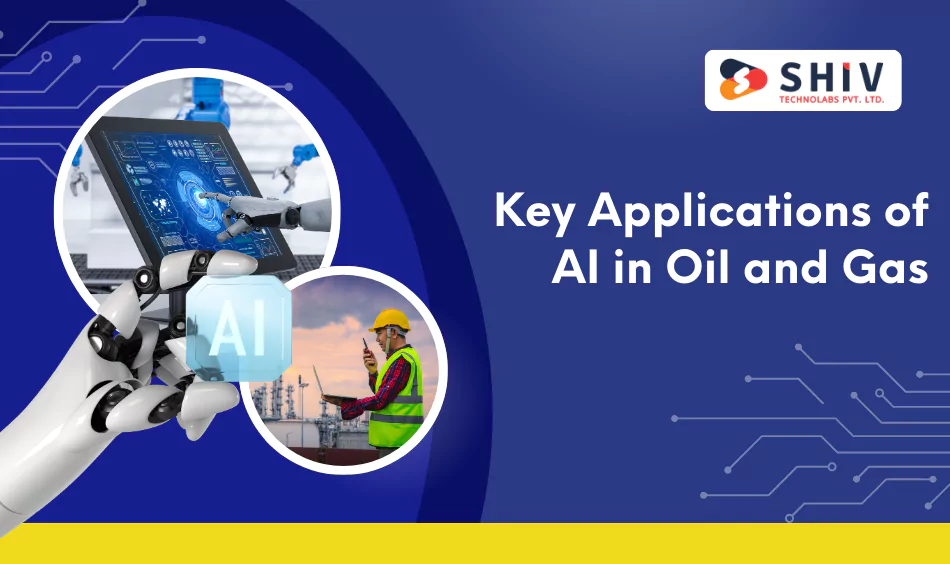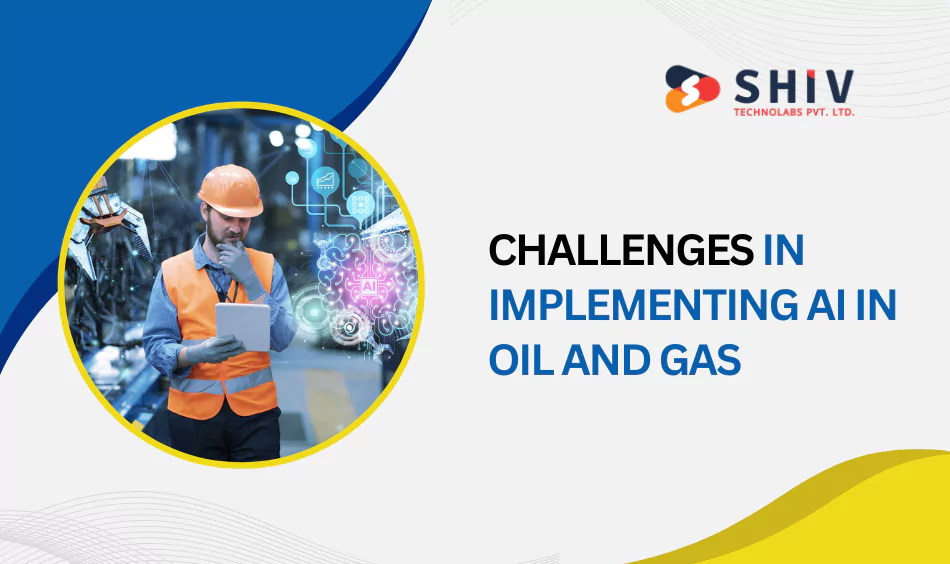Table of Contents
AI in oil and gas industry generates massive amounts of data every day, from seismic surveys to equipment sensors with IoT solutions.
According to McKinsey, offshore platforms can produce over 1 TB of data daily, but less than 1% of it is analyzed effectively. This shows how much valuable information often goes unused.
Artificial intelligence (AI) is helping change that. Reports suggest that AI adoption in oil and gas could cut production costs by up to 20% and reduce unplanned downtime by 30–50%.
Predictive maintenance alone is estimated to save the industry over $200 billion annually by avoiding equipment failures and costly delays.
Beyond efficiency, AI also plays a major role in safety and sustainability. AI-powered monitoring systems can detect leaks, prevent accidents, and help companies reduce carbon emissions.
With energy demands continuing to rise, these technologies are becoming essential for reliable and responsible operations.
Why Use AI in Oil and Gas Industry?
Oil and gas operations involve some of the most complex industrial processes in the energy sector. From finding new reserves to transporting fuel across continents, every stage generates huge amounts of data. Traditional systems struggle to process this information fast enough to support critical decisions.
This is where AI makes a difference. By applying machine learning and advanced analytics, companies can turn raw data into clear insights.
AI also plays a key role in reducing risk. For example, predictive algorithms can detect equipment stress or early signs of failure, preventing accidents before they happen.
AI is not just a technical upgrade; it has become central to lowering costs, improving safety, and making faster, more reliable decisions.
Key Applications of AI in Oil and Gas

Artificial Intelligence is shaping nearly every stage of oil and gas operations, from exploration to supply chain. Let’s look at the major applications in detail:
1. Exploration and Reservoir Analysis
Finding new oil and gas reserves has always been costly and uncertain. Traditional methods rely on seismic surveys and manual interpretations, which can take months and still leave gaps.
AI speeds this process by analyzing seismic data, satellite imagery, and historical drilling records with greater accuracy.
Machine learning models can identify patterns in geological formations that human experts might miss.
According to Accenture, AI-driven tools can reduce exploration costs by up to 15%, while also increasing the probability of locating economically viable reserves.
This not only saves money but also minimizes the environmental footprint by reducing unnecessary drilling attempts.
2. Drilling Optimization
Drilling is one of the most expensive and high-risk phases of oil extraction.
Each well can cost millions of dollars, and even small delays or mistakes can lead to huge losses. AI helps operators monitor drilling conditions in real time, tracking variables such as drill bit pressure, rotation speed, and temperature.
By predicting how equipment will respond under different geological conditions, AI allows for instant adjustments that reduce wear and tear.
According to Oil & Gas IQ, AI-enabled drilling solutions have reduced non-productive time by up to 20%. This translates into faster drilling, lower fuel consumption, and safer operations.
3. Predictive Maintenance
Equipment such as pumps, compressors, and turbines is the backbone of oil and gas production. A sudden failure in one machine can halt production for days, causing multi-million-dollar losses.
AI-powered predictive maintenance systems use sensors to collect data on vibration, temperature, and pressure.
Advanced algorithms analyze this data to forecast when a component is likely to fail. This allows companies to schedule maintenance before breakdowns occur.
The International Energy Agency (IEA) estimates that predictive maintenance can lower maintenance costs by up to 40% and reduce downtime by 30–50%.
For an industry that depends on reliability, this is one of the most impactful uses of AI.
4. Production Efficiency
Keeping wells productive and energy use efficient is a constant challenge. AI systems analyze production data in real time to identify bottlenecks and inefficiencies.
For example, if pressure levels in a reservoir are dropping, AI can recommend adjustments to injection rates to maintain output. These adjustments can extend the productive life of wells and increase total output.
Studies suggest that AI-powered optimization can raise production efficiency by up to 10%, which means higher yields without increasing operational costs.
In a field where every barrel counts, this impact is significant.
5. Supply Chain and Logistics
Oil and gas companies rely on massive global supply chains, from transporting crude oil through pipelines to delivering refined products across continents.
Managing these logistics is complex, with risks ranging from demand fluctuations to geopolitical disruptions.
AI tools analyze demand forecasts, weather patterns, and transportation routes to improve supply chain reliability. Predictive models can recommend the most efficient shipping schedules, lowering fuel costs and reducing delays.
Gartner notes that AI in supply chains can reduce logistics expenses by up to 15% while improving delivery consistency. This ensures energy gets where it is needed, when it is needed.
6. Safety and Environmental Monitoring
Safety is one of the most critical concerns in oil and gas. AI-powered systems equipped with cameras, sensors, and IoT devices constantly monitor conditions in real time.
They can detect gas leaks, equipment malfunctions, or unsafe worker behavior instantly.
For example, computer vision can identify whether workers are wearing safety gear, while predictive models can forecast the likelihood of pipeline corrosion.
The World Economic Forum reports that AI-based monitoring can reduce workplace accidents by up to 20%.
On the environmental side, AI helps companies minimize emissions, track spills, and maintain compliance with regulations.
By identifying risks early, AI protects not only workers but also the communities and ecosystems around production sites.
Benefits of AI Adoption in Oil and Gas
The use of AI brings several advantages that go beyond just technical improvements. It helps companies work smarter, safer, and more efficiently across every stage of operations.
1. Lower Costs
By predicting issues and improving processes, AI reduces unnecessary expenses and makes better use of resources.
2. Less Downtime
Smart systems anticipate problems before they occur, helping operations continue without unexpected interruptions.
3. Safer Workplaces
AI-powered monitoring tools detect risks early and create safer conditions for workers in high-risk environments.
4. Greater Efficiency
Real-time insights allow companies to adjust operations instantly, keeping production smooth and reliable.
5. Support for Sustainability
AI helps reduce waste, cut emissions, and run operations in a more environmentally responsible way.
6. Smarter Decisions
By turning raw data into actionable insights, AI gives leaders the clarity they need to plan with confidence.
Adopting AI is not just about technology; it’s about building a stronger foundation for long-term growth and resilience in the energy sector.
Challenges in Implementing AI in Oil and Gas

Adopting AI in oil and gas brings great potential, but the path is not without difficulties. Companies often face both technical and organizational barriers.
- Data Quality Issues – Incomplete or inconsistent datasets reduce the accuracy of AI models.
- Legacy Systems – Old infrastructure makes integration with AI tools slow and costly.
- High Initial Costs – Investment in sensors, cloud storage, and computing power is significant.
- Skill Shortage – Lack of professionals skilled in both AI and energy operations slows adoption.
- Cybersecurity Risks – Digital systems connected to critical infrastructure face higher attack risks.
Overcoming these challenges requires a clear strategy, strong data governance, and investment in talent and security. Companies that address these issues early will be better positioned to gain long-term value from AI.
Future of AI in Oil and Gas
The role of AI in oil and gas is set to grow even further in the coming years. As companies push for greater efficiency and cleaner operations, AI will be at the center of this shift.
- Digital Twins for Real-Time Monitoring – AI will drive the adoption of digital twin technology, allowing companies to create virtual models of rigs, pipelines, and refineries. Gartner predicts that by 2027, over 75% of large industrial companies will use digital twins to improve efficiency and reduce downtime.
- Autonomous Drilling and Robotics – AI-powered robotics will reduce human involvement in high-risk drilling environments. This will not only cut costs but also improve worker safety by keeping people away from hazardous zones.
- AI in Carbon Reduction – With increasing focus on sustainability, AI will play a major role in lowering emissions. According to McKinsey, AI-driven energy efficiency improvements could reduce greenhouse gas emissions by up to 15% in oil and gas operations.
- Integration with Renewable Energy – Oil and gas companies are diversifying into renewables. AI will help balance energy grids, forecast renewable generation, and manage storage alongside traditional fuels.
- Smarter Supply Chains – AI will make energy logistics even more predictive, with systems that adjust transport schedules automatically in response to demand, weather, or political changes.
Looking ahead, companies that invest early in AI will be better prepared for a future shaped by efficiency, safety, and sustainability.
Ready to Bring AI into Your Oil and Gas Operations?
At Shiv Technolabs, we help energy companies apply AI where it matters most: exploration, drilling, predictive maintenance, and supply chain management.
Our team builds custom oil & gas software that are AI-powered. Designed to improve efficiency, cut downtime, and make operations safer.
Whether you need predictive analytics, digital twin solutions, or real-time monitoring dashboards, we create technology that supports long-term growth. With the right AI strategy, your business can move faster, stay safer, and reduce costs.
Key Takeaway
Artificial Intelligence is no longer just an experimental tool for oil and gas; it has become a practical driver of efficiency, safety, and sustainability. From smarter exploration to predictive maintenance and safer operations, AI is reshaping how companies manage complex processes.
While challenges such as data quality, high costs, and integration remain, the long-term benefits far outweigh the barriers. Companies that adopt AI early gain faster decision-making, reduced downtime, and stronger safety records.
As the Oil & Gas industry continues to evolve, those embracing AI will lead the way in building reliable and sustainable energy operations.
📞 Let’s discuss how AI can reshape your operations – Reach Out to Start Your Project Today!























